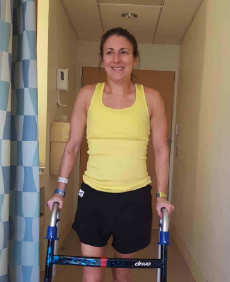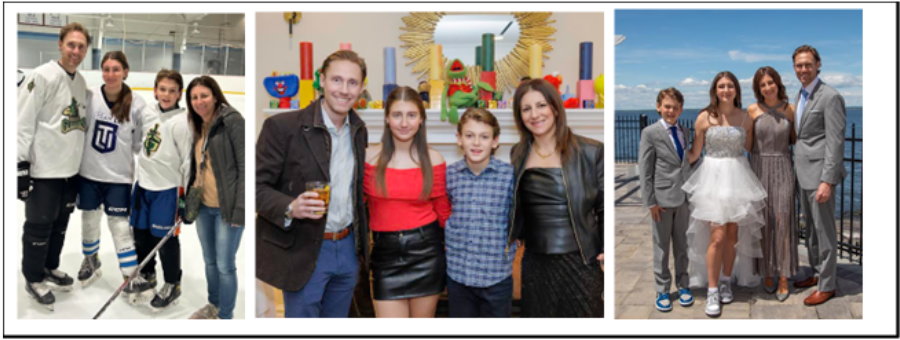
This year in August it will be 10 years since my life changed forever. In August of 2015 after returning from a beach vacation, something didn’t feel right with my legs so I checked myself into the Emergency Room at NYU in New York City, a few blocks from my apartment to see what was going on. My legs felt like they were cramping or I was dehydrated - it was a strange feeling in my muscles but not overly alarming. The hospital sent me home and gave me muscle relaxers. The next day I was unable to urinate and called the ER and they said I had to come back. Over the next couple of hours, we realized that I was not able to go to the bathroom so something strange was going on. I stayed overnight and when I woke up, as I tried to walk when getting out of bed my legs gave out from under me, and I collapsed. I was completely paralyzed from the waist down. I was in the hospital for 10 days receiving a battery of diagnostic tests and treatments that included MRIs, a spinal tap, intravenous steroids, catheters, IVIG immuglobin infusions and plasmapheresis which required a central line. I had six MRIs of my spine and brain. The MRIs showed that I had lesions throughout my spinal cord. I was scared out of my mind.
Ironically, the week this all happened I was in between a major job change (I had accepted a new job offer but had not yet resigned from my employer of 15 years). All of a sudden, it was unclear if I was going to be able to walk again or work in the same capacity as a few days prior. I went on short-term disability with my current employer with my future work status an uncertainty. At the hospital they told me that I was going to need to go to inpatient rehabilitation and were not sure if I would be able to walk again. I also could not urinate and needed a straight catheter every few hours. I was diagnosed with Transverse Myelitis (which means inflammation of the spinal cord).


My doctors, therapists and nurses were hard-working, caring and dedicated individuals. It was clear to me after a few days at Rusk that I could make improvements and maybe be able to walk again if I worked hard and listened to my team. I wasn’t so sure if and when I would meet my 2nd goal, and it was hard to stay positive. The days were long and the work was grueling but there were bright spots. After four weeks at Rusk, it was finally time to go home and I was nervous but relieved.

The day after I got home was a set back. I had to be rushed to the ER due to an infection that led to sepsis and landed in the ICU. After spending another week in the hospital, I was able to finally return home for good. I started outpatient physical therapy a few days after coming home and over time transitioned from a walker to crutches until eventually, I could walk with no support. I saw improvement every day but it was hard and frustrating to navigate in my home environment with two little kids.
After a few weeks at home, I decided to leave my job of 15 years and take the new job, which was a unique opportunity and a bigger role. I made this decision with the support of my family and friends (and some my therapists from Rusk!) after much deliberation. I was lucky to have the tremendous support of my friends and coworkers both at my current job and my new job. I started my new job in mid-December, 2015, able to walk without support, but with deficits in many areas and in physical therapy. As an avid runner (completed four marathons), not being able to run was not something I was willing to accept as my future. After much hard work and physical therapy, within three months from the initial incident, I was able to run. Not as fast and hard as before but I could run and it was a huge milestone. 10 years later I’m still running despite that I have had to make modifications to deal with severe bladder and bowel challenges which would cause anyone else to hang up their running shoes.
When I got home from the hospital I found a care team at the Weill Cornell Medicine Multiple Sclerosis Center. Dr. Jai Perumal became my lead neurologist in charge of my care and under her direction we decided on a 6-month precautionary treatment of IVIG. All signs pointed to a one-time occurrence of Transverse Myelitis; my doctors thought they had identified a mycoplasma that caused this and there was no reason to think it would come back my scans MRI scans were clear after six months with no new lesions which was good news.
In July of 2016, after feeling not right for about a week with cold symptoms and a pain in my right ear and headache on one side, I woke up one morning and my right hand was numb. When I woke up the next morning and it was still numb, I went to the Emergency Room to get it checked out. I didn’t suspect anything was seriously wrong, and neither did the ER team. I was so confident it was ‘nothing’ that I told my husband I would be OK on my own and would be home soon. After spending the day at the ER and full repeat MRI scans of my back, it wasn’t good news. The Transverse Myelitis was back in new areas - new active lesions were found in my cervical spine. Thanks to the care team at Weill Cornell, it was quickly under control with five days of IV steroids followed by a week of IVIG and the issue was contained to my right arm, hand and a little bit of my right side. It was devastating news that this was happening again. I now was faced with the news that I had a recurring autoimmune neurological issue, not a one-time thing. Starting in 2016 I started regular infusion treatments that I will undergo for the rest of my life.
Reflecting back on the past 10 years, I’ve learned how to live with a rare neuro-immune disorder while balancing a busy family life and demanding job which is not easy. I’ve learned to be an advocate for those with disabilities – both visible and invisible in my personal and professional life. I’ve learned to live with extreme bladder, bowl and nerve damage issues. I will need to get a monthly infusion for the rest of my life and I take that day each month to reflect on how lucky I am to be able have a team to help me manage my condition.
2025

Some lessons I’ve learned along the way:
1) You must have a care team and a care plan. I’m lucky that I found Dr. Jai Perumal at the Weill Cornell Multiple Sclerosis Center – over the past decade she has helped me navigate my condition. You need to find a provider who you can ask tough questions and feel comfortable with and discuss various scenarios.
2) Accept help from others. Even 10 years later I sometimes try to do everything on my own. I needed to accept help along the way – it’s a gift to allow others in to help, accepting it can be hard but it doesn’t mean you are weak – in fact it means you are strong.
3) Tell your story; it can help others. I’ve told my story in a few forums. I’m a Hope Ambassador for the Siegal Rare Neuroimmune Association (SRNA) and told my story in my professional life as well. When you allow yourself to be vulnerable, you help yourself as well as others on their journey.
4) Listen to your body. You know yourself. If something doesn’t seem right – don’t wait to get it checked out or it could be too late. Be your own advocate and change your medical team if you have to or get a second opinion.
5) Keep up to date with options, tests and medications. A few years ago, a new classification came out called MOG antibody-associated disease which is a demyelinating disease that can affect the brain, spinal cord, and optic nerves leading to a range of neurological symptoms including inflammation of the spinal cord. I tested positive for the MOG antibody reflex titer test – the first time I tested positive for something that has the exact symptoms of my conditions. While it’s just a data point, it confirmed for my care team that my monthly infusions would need to continue to prevent the risk of a relapse.
5) Don’t let your disability define you, let your ability define you. Having a rare neuro-immune disorder means that some things are harder for me and I have to stay on top of my health but I’m so thankful for all the things I CAN do. When things get me down about my current condition – I try to think in my head that ‘my ability defines me’, not my disability.
I would encourage others who are faced with a rare neuro-immune disorder not to give up, to fight the good fight and continue to follow their dreams. They are possible. A positive attitude, keeping your sense of humor in the midst of impossible situations and accepting help from others has helped me to be resilient in the face of the most difficult and traumatic experience I have ever faced. I’m grateful that I gained a completely new perspective of what it is like to be paralyzed, be confined to a wheelchair, and be completely reliant on others for help and out of my comfort zone. Those who deal with these issues on a regular basis are inspirational. I’m grateful for the champions I met along this journey… my therapists, nurses, and doctors who took care of me at my lowest points and my nurse who sits with me each month during my infusions. I hope me telling this story inspires others who are struggling not to feel isolated, to keep fighting and never give up and share their story with others. I now accept this is part of who I am and who I will be in the future and I don’t need to hide what happened to me, I can be proud of how far I have come and humbled by others who have disabilities and limitations and learn from their resolve and resilience.

